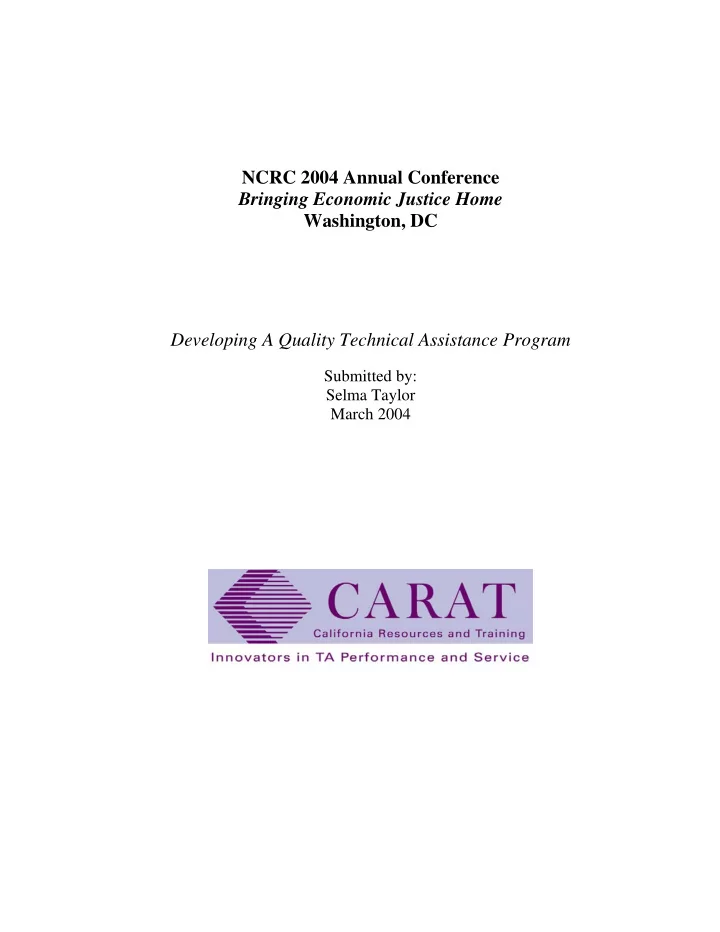

NCRC 2004 Annual Conference Bringing Economic Justice Home Washington, DC Developing A Quality Technical Assistance Program Submitted by: Selma Taylor March 2004
Technical Assistance (TA) is defined as any intervention methodology used to develop, sustain and grow small businesses. The common types of TA tools used in today’s marketplace are training, one-on-one consulting, coaching and mentoring. Training, Consulting, Coaching, Mentoring Small businesses have different stages of growth that warrant different types and levels of technical assistance. Group training is effective for the start-up and micro-enterprises. One-on-one consulting and topic specific training is more effective for second stage growth based businesses. Industry specific and customized consulting is required for third stage businesses that are successfully competing in the market place with a substantial asset base. Coaching and mentoring are support tools that are integrated with consulting and topic specific training. Role of Non-profits Non-profits play a role that bridges the services provided by the government and private sector. The bureaucracy of public sector many times is too inflexible to meet the immediate needs of small businesses. Private sector services are often too costly for emerging and small businesses. Non-profits, through subsidies from the government and contributions from the private sector, are able to provide services that are flexible to meet specific needs at affordable costs. Current Issues Quantifying the value of technical assistance, providing quality technical assistance and organizational sustainability are ongoing discussions. There is movement from anecdotal documentation to evaluative measures. Strategic funding partners are requiring quantifiable performance measures. Quality assistance requires skilled professionals and adequate consulting tools. Businesses require assistance that impacts their growth. Organizational sustainability requires planning for adequate resources to maintain the appropriate infrastructure to meet the market needs of small business clients.
Capacity Building TA Capacity building is defined as increasing the ability of the organization to delivery quality services that adequately address the needs of the small business client base. Organizational capacity building is essential for attracting much needed resources to build internal infrastructure, attract and retain quality professional staff, and engage in program development. Best Practices California Resources and Training (CARAT) has developed a Technical Assistance Capacity Building Program (TACP) that uses a diagnostic tool to evaluate the performance of non-profit technical assistance organizations in the areas of organization and management, service delivery, and client impact. The TACP includes the diagnostic tool and capacity building training. The components of the diagnostic tool include an evaluation of the following organizational and service delivery areas: • Organizational business planning • Financial sustainability • Internal Systems • Professional staff skills and expertise • Services requested vs. services delivered • Client driven vs. case management • Work product • Client Satisfaction • Client Impact The capacity building training includes group training on specific topics related to the management of the organization, such as organizational planning, infrastructure development, and funding diversification. The second area of the training involves professional development of the staff. The training includes the introduction of consulting tools for business assessments, providing financial analysis and financial management services, and delivering marketing work products. The final area is in measuring client impact and evaluating program effectiveness. Benefits Organizational sustainability is dependent upon strategic partnering and strategic alliances with both the public and the private sector. These partners bring resources to the TA organizations that are needed to develop and deliver programs for the small business clients. Quality service delivery as defined in the “best practices” section is necessary to attract resources from partners. The organizations demonstrate and communicate the benefits to the strategic partners. Benefits include: extension of reach into the emerging markets, delivery of more cost effective products and services, growing small
business customers, and maintaining the stability of the small business community which is a significant component of the nation’s economic base. Concluding Observations The Technical Assistance (TA) industry is comprised of a variety of organizations serving a diverse population of small businesses at various stages of growth. Change and continuous improvement in how services are delivered is critical for advancement of the industry. Better communication, documentation, and performance measures are needed to attract adequate funding from both public and private sector strategic partners. Authored by: Selma Taylor, Executive Director California Resources and Training (CARAT) 1333 Broadway, Suite 604 Oakland CA 94612 Phone: 510-267-8994 Fax: 510-835-1332 Email: staylor@caratnet.org Web: www.caratnet.org
Recommend
More recommend